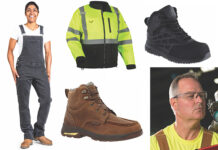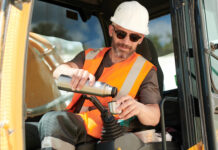On National Hydration Day (June 23) last month, Turf posted tips from Magid on the importance of hydration in beating heat related illnesses. But as summer temperatures soar, there’s more to keeping employees cool beyond essential water and electrolyte-replacing drinks. According to Magid, here are other aspects an employee cooling station or heat safety program should include:
- The lightest PPE that provides protection.

Ergodyne Chill-Its 6260 Lightweight Phase Change Cooling Vest with Packs. - Body-cooling gear, like conductive/phase change cooling vests or evaporative vests. Even cold, wet towels can provide relief at a low cost. But they need to be rotated after one to two minutes so workers can get the most cooling potential out of them. One study found that towels that were not rotated after one to two minutes became warmer and kept core temperatures the same or made them even warmer than before.
- Frequent breaks in the shade. Pop-up utility tents can also provide shade for a specific area if no natural shade is available.
- Mist-fans, portable evaporative coolers, and regular fans can aid cooling.
- Water dousing with a cool water source such as a water bottle, hose, or a shower can be used to help workers wet their skin and cool down. A 2019 study found that water dousing reduced thermal and cardiovascular strain in hot and humid conditions as well as hot and dry conditions, too.
- Extremity immersion (dipping hands or arms into ice water) can be done with a container the size of a water cooler and was shown to lower core temperature and heart rate in academic research. Workers can also keep PPE (like hard hats and safety vests) on while they cool their hands or forearms. Note that extremity immersion is not a remedy for heat stroke and that whole body cold water immersion is the recommended procedure.
- Modifying the work-to-rest ratios in hotter working conditions.
- Knowing the signs and symptoms of heat related illness and what to do. Click here for a CDC chart.

For more information, visit the Magid Safety Matters® Resource Center.
For an article on “Landscape Workwear To Help Keep Your Cool, click here.











![[VIDEO] Dickies®: Discover Workwear That’s Anything But Uniform](https://turfmagazine.com/wp-content/uploads/2023/06/1647663814-4b1a2a7742790a9b1e97a3b963477850192e1d6a9dfba9b07214a77bae25d6e3-d-218x150.jpg)






























![[VIDEO] Dickies®: Discover Workwear That’s Anything But Uniform](https://turfmagazine.com/wp-content/uploads/2023/06/1647663814-4b1a2a7742790a9b1e97a3b963477850192e1d6a9dfba9b07214a77bae25d6e3-d-324x160.jpg)